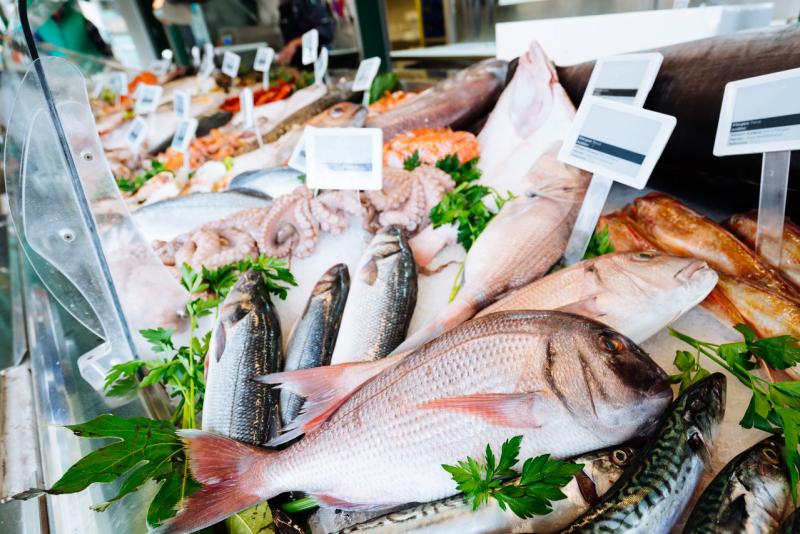In the fight to ensure that our seafood is safe, legally caught, and accurately labeled, traceability is a critical tool. It ensures that information such as how and where fish are caught or farmed—from capture to market—is accessible throughout the global seafood supply chain. The complex interactions between supply chains and actors, however, produce challenges. They can make it difficult for traceability programs to be used effectively, an issue that illegal, unreported, and unregulated (IUU) fishing operators can exploit. Experts from various nations recently gathered to discuss challenges, innovations, and best practices of their traceability programs. They have released a summary report of their meeting.
Co-hosted by NOAA Fisheries, the Stimson Center, and World Wildlife Fund, the unique workshop was held September 14–15, 2021. “In combating IUU fishing, we can’t rely on any single tool, we must utilize the variety of resources at our disposal, '' said Alexa Cole, Director of NOAA Fisheries Office of International Affairs, Trade, and Commerce. “Traceability is an important tool for maintaining the safety of our seafood, deterring illegal practices, verifying sustainability, ensuring products are caught legally, and are not misrepresented.”
Participants included representatives from more than 35 fishery agencies and ministries, non-governmental and international intergovernmental organizations. “Experts shared ideas on ways to enhance global traceability through the use of technologies, big data analytics, improved global harmonization of seafood data, and to use information to improve enforcement,” said Sally Yozell, Senior Fellow and Director of the Environmental Security Program at the Stimson Center. “Being able to track seafood throughout the global seafood supply chain from where it is caught to when it enters the market will advance the international fight against illegal fishing and seafood fraud. No one wants to unknowingly purchase or consume seafood that is illegally caught, comes from an unmanaged fishery, or is harvested using forced labor.”
Practitioners discussed components of existing traceability programs, such as the EU Catch Certificate Scheme and the U.S. Seafood Import Monitoring Program. They focused on the fundamentals of the regulatory systems used by these programs, including:
- Key data elements
- Improvements being considered
- Verifications
- Challenges for small-scale fishers
Technology as a Key Tool
The use of technology was highlighted as a key solution to several long-standing issues. However, there were concerns about the changing technological requirements. For example, there needs to be more research into how countries can bridge the technological gap for small-scale fishers and promote interoperability between national systems.
“Facilitating collection of information and sharing it in a universally understandable way are important steps forward. This must be followed up by maximizing the utility of the information to even the playing field for all involved in the fisheries supply chain, and when appropriate, using it to enforce legal requirements, said Michele Kuruc, Vice-President of Ocean Policy at the World Wildlife Fund. “Making these changes will help protect the incredible biodiversity of our oceans as well as the livelihoods of the hundreds of millions of people dependent on fisheries.”
Common Themes Raised
- Practitioners also explored how governments can work together to review and validate data, engage in virtual capacity building, and use other efforts to improve these systems. Some key ideas included:
- Standardizing and securing electronic data throughout the seafood supply chain to manage the chain-of-custody, facilitate compliance with legal requirements, and improve enforcement cases
- Adopting new traceability schemes and requirements for more countries which would facilitate the standardization of key data elements, data collection and data sharing, and interoperable data systems
- Establishing systems to accurately verify integrity of traceability data
- Ending the reliance on paper-based systems, which can be falsified in the supply chain, and increasing the interoperability of traceability systems and government databases to improve efforts to verify compliance of catch documentation and traceability requirements
- Supporting technologies such as blockchain that can link and store records in networks online while providing a potential solution to the issue of data storage
Public and private stakeholders working together advance the necessary dialogue on international cooperation on seafood traceability as a tool to counter IUU fishing. Bringing together experts who have first-hand knowledge of the challenges of program design and implementation, allows governments and industry to better understand how to develop future traceability programs to be more effective and efficient.
The workshop is the first in its series. Open communication and collaboration will be fundamental as practitioners seek to implement, optimize, and comply with traceability schemes around the globe.
View the Seafood Traceability Practitioner's Workshop Summary Report



